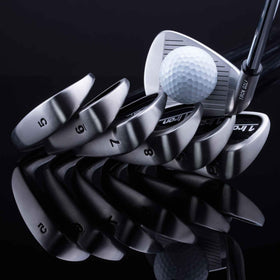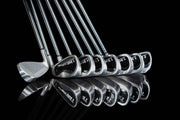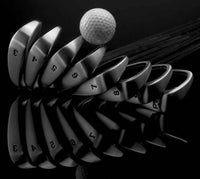Wedge Play with Single Length Irons
by David Lake
The term “wedge” holds no specialized meaning as wedges are nothing more than the logical extension of a set of irons whether they be conventional irons or single length irons. In other words, for all practical purposes a PW could be called a #10 iron, GW an #11 iron and so on. The only truly specialized wedge is the SW which as its name implies is designed to get a ball out of a bunker without digging straight down into the sand. This is typically accomplished by increasing the bounce angle on this wedge. The problem with a typical SW is that this bounce angle is generally increased to 12º to 14º which makes it fine for sand play but virtually worthless when hitting from a close cut fairway. If you tend to blade your fairway shots with your SW this is the reason. When I designed our 1 Iron single length sand wedge I specifically addressed this problem because I not only wanted the equivalent of a #12 iron for fairway play but also an iron that would not dig when hitting from a bunker. Therefore, I designed our SW with only a 6º bounce angle which produced a very effective fairway iron and then widened the sole which prevents the clubhead from digging into the sand when hitting out of a bunker. So in essence a full set of 1 Irons is comprised of a #3 through #9 plus #10, #11, #12, and #13 (LW) irons.
The advertising hype of most golf companies when it comes to their wedges always makes me laugh. They try to invoke in the consumers mind that there is something mystical about wedge play and their own particular line of wedges. Nothing could be further from the truth as wedges should be played in exactly the same manner as every other iron in your bag. 1 Iron wedges are identical to all of the other irons within a set: same weight, clubhead lie angle, offset, club length, etc. and should certainly be played using the same swing, ball position, set-up, etc as you would the rest of the irons. I should mention here, as I have mentioned over and over within previous Golf Tips articles, that you should never alter your set-up or choke down on any club for any shot.
Now, let me explain why you want to carry a full set of wedges. Let’s assume that you are an average golfer of average strength and your distance with your 1 Iron PW is 115 yards. If you did not carry additional wedges other than a different brand SW which you cannot hit from the fairway (many of our customers opt to stay with their old wedges instead of investing in those that match the rest of their irons – go figure?), you would have to master all of the distances from 115 and in using your PW. If you added a GW this would be reduced to 105 yards, with a fairway playable SW this would be reduced to 95 yards, and with a LW this would be reduced to 85 yards. The fact is that it is far easier to develop a feel for distances within 85 yards using one iron than 115 yards (a 30 yard difference). Not carrying a full set of wedges is the equivalent of carrying a #3, #4, and #5 iron and then skipping to a #9 iron. As you can guess it would be very difficult to master the different distances between your #5 and #9 irons using only your #5 iron.
There is another advantage for using a LW for all shots within the 85 yards in the above example as opposed to your PW within 115 yards and that has to do with trajectory. Say for instance you have a 40 yard pitch shot to the pin and you use your PW for this shot. Due to the trajectory associated with a PW the ball will hit and then roll quite a bit making it that much more difficult to judge distance correctly. On the other hand, this same shot made with a LW will produce a much higher trajectory where the ball will land and stop making distance judgments far easier.
Personally, I have carried a full set of wedges in my bag for the past twenty years and would not consider playing a round without them.










